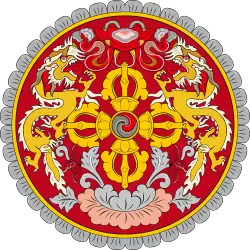Druk tsendhen
Druk Tsenden (Dzongkha: འབྲུག་ཙན་དན, Dzongkha pronunciation: [ʈuk̚˩ t͡sen˥.te˩]; The Thunder Dragon Kingdom") is the national anthem of Bhutan. Adopted in 1953, the lyrics were written by the Venerable Dorji Lopen Dolop Droep Namgay of Talo, Punakha and possibly translated into English by Dasho Gyaldun Thinley. The accompanying music was composed by Aku Tongmi.[1]
| English: 'The Thunder Dragon Kingdom' | |
|---|---|
| འབྲུག་ཙན་དན་ | |
 | |
National anthem of | |
| Lyrics | Dorji Lopen Droep Namgay Dasho Gyaldun Thinley |
| Music | Aku Tongmi |
| Adopted | 1953 |
History
Despite claims made in Brozovic's Enciklopedija (1999) and many subsequent authors, who attribute the authorship of this most sacred national compilation to the late Gyaldun, father of the (now) former Prime Minister Jigme Y. Thinlay (2008–2013), there are many who believe that the words and the national anthem itself were penned by none other than the much learned and Venerable Dorji Lopen Dolop Droep Namgay of Talo, Punakha. The Dorji Lopen is the senior-most of the four senior Lopens in Bhutan's religious establishment, and often serves as the Deputy Je Khenpo. Dolop Droep Namgay, given his extensive knowledge and wisdom, maintained close personal and working relations with the Third King of Bhutan Jigme Dorji Wangchuck (1929–1972), during whose reign, Gyaldun Thinley served in various capacities.
It is possible that Gyaldun Thinlay may have been involved in working closely with Dolop Droep Namgay as well as translating the lyrics into English. It is also highly likely that he (and/or his son Jigme Y. Thinlay who served in many important government and political capacities since the 1990s) was one of the persons of first contact for Dalibor Brozovic and any such claims made therein, remained part of Bhutan's history, with little or no investigative work done thereon. However, as to the claims that this anthem could have originated, much less penned by Gyaldun Thinley, who, despite his rise through the ranks and importance to Bhutan's history, is not much known for his knowledge or learning, is not viewed favorably or seriously by many. Dolop Droep Namgay on the other hand, through oral tellings again, is renowned for both learning and wisdom.
He is also attributed (under the guidance and specific command of His Majesty The Third King Jigme Dorji Wangchuck) to have designed, named and conveyed the significance of many important national symbols and emblems - most of which are commonly known but not as well documented. Examples are the titles and insignias of the various ranks in the armed forces - Makpoen, Lingpoen, Drimpoen, etc. which translate into General, Lieutenant, Sergeant and so on for the three groups of Bhutan's armed forces; the Royal Bhutan Army, the Royal Bhutan Police and the Royal Body Guards. Furthermore, these titles and insignias are believed to be derived from an extensive research and study of the Namthar of Ling Gesar (Biography of King Gesar) by the learned Lopen Namgay. Most of these refutations are not documented. They are oral tellings from older to the younger generation. A more thorough and academic investigation may be necessary to determine the true origins of the Druk Tsendhen; be it a lay civil servant or a learned high-monk.
Tongmi was educated in India and had recently been appointed leader of the military brass band when the need for an anthem rose at the occasion of a state visit from Prime Minister Jawaharlal Nehru of India. His original score was inspired by the Bhutanese folk tune "The Unchanging Lotus Throne" (Thri nyampa med pa pemai thri). The melody has twice undergone changes by Tongmi's successors as band leaders. The original lyrics were 12 lines, but was shortened to the present six-line version in 1964 by a secretary to the king.[2]
As the anthem is inspired by a folk tune, there is a choreography to it as well, originally directed by Tongmi.[2][3]
Lyrics
The lyrics to the national anthem are inscribed in the Constitution of Bhutan.[4]
| Original in Dzongkha | Roman Dzongkha | English translation |
|---|---|---|
འབྲུག་ཙན་དན་བཀོད་པའི་རྒྱལ་ཁབ་ནང་།། |
Dru tsend°en kepä gäkhap na |
In the Kingdom of Bhutan adorned with cypress trees, |
References
- Brozović, Dalibor (1999). Hrvatska Enciklopedija. 1. Miroslav Krleža. p. 569. ISBN 953-6036-29-0. Retrieved 2011-10-29.
- Penjore, Dorji; Kinga, Sonam (2002). The Origin and Description of The National Flag and National Anthem of The Kingdom of Bhutan (PDF). Thimphu: The Centre for Bhutan Studies. p. 14. ISBN 99936-14-01-7. Archived from the original (PDF) on 2011-07-23. Retrieved 2011-04-19.
- Blackwell, Amy Hackney (2009). Independence Days: Holidays and Celebrations. Infobase Publishing. p. 15. ISBN 978-1-60413-101-7. Retrieved 2011-10-29.
- "Bhutan: The Constitution of the Kingdom of Bhutan". www.wipo.int. Retrieved 2018-10-27.
- "National Anthem". Bhutan Portal. Government of Bhutan. Archived from the original on 2012-02-09. Retrieved 2011-10-29.
- This transcription is based on the official Dzongkha romanization by Dr. George van Driem, see http://www.himalayanlanguages.org/files/driem/pdfs/1991Romanization.pdf
- "Constitution of Bhutan" (PDF). Archived from the original (PDF) on 5 September 2014. Retrieved 18 October 2014.
Further reading
- Minahan, James (2009). The Complete Guide to National Symbols and Emblems. 1. Greenwood Press. p. 20. ISBN 978-0-313-34498-5. Retrieved 2011-10-29.
External links
- Druk tsendhen - Audio of the national anthem of Bhutan, with information and lyrics
- National anthems.net midi file
- Dookola Swiata - This travel website has an instrumental version of the Anthem, as an .asx file.
- Children sing the anthem - This website has a sound file of Bhutanese children singing the Anthem without musical accompaniment.
- Dragon King of Bhutan calls-on President of the Republic of India on the eve of 63rd Republic Day - The anthem starts at 01:30. Rendition by Rashtrapati AngRakshak.